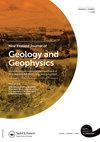Pleistocene marine terraces of the Wellington south coast – their distribution across multiple active faults at the southern Hikurangi subduction margin, Aotearoa New Zealand
IF 1.9
4区 地球科学
Q1 GEOLOGY
New Zealand Journal of Geology and Geophysics
Pub Date : 2022-01-02
DOI:10.1080/00288306.2021.2011329
引用次数: 2
Abstract
ABSTRACT Along the south coast of the North Island of New Zealand, elevated Pleistocene marine terraces provide evidence for vertical deformation associated with active crustal faults and the westward subduction of the Pacific Plate at the southern Hikurangi margin. We have reassessed the age and elevation of these terraces. Optically Stimulated Luminescence (OSL) data of their cover bed sediments (20 new ages) provide the first numerical ages for most of these terraces. Shore platform elevations have been surveyed using differential Global Navigation Satellite System (GNSS) measurements of the wave-cut bedrock straths underlying these terraces. These new data allow the terraces to be temporally correlated across the margin. Seven different-aged terraces were identified and mapped along the Wellington south coast; these are preserved discontinuously between the westernmost site at Tongue Point, and Ngawi near Cape Palliser, to the east. The OSL data indicate that most of these terraces formed at MIS 5a, 5c, 5e (Last Interglacial) and 7a. The terraces are best preserved within the Hikurangi margin forearc, where they decrease in altitude towards the west, indicating long wavelength, westward tectonic tilting. The terraces are locally offset by a number of active crustal faults, most notably the Wairarapa and Ohariu faults.惠灵顿南海岸的更新世海洋阶地——它们分布在新西兰奥特亚Hikurangi俯冲边缘南部的多个活动断层上
在新西兰北岛南海岸,抬升的更新世海相阶地提供了与活跃地壳断裂和太平洋板块西向俯冲相关的垂直变形的证据。我们重新评估了这些梯田的年龄和海拔高度。其覆盖层沉积物的光激发发光(OSL)数据(20个新时代)提供了大多数阶地的第一个数值年龄。使用差分全球导航卫星系统(GNSS)测量这些阶地下面的波浪切割基岩海峡,测量了海岸平台的高度。这些新数据使得阶地可以在时间上跨越边缘相互关联。沿着惠灵顿南海岸确定并绘制了七个不同年龄的梯田;它们断断续续地保存在最西端的舌点遗址和东部帕利瑟角附近的恩加维之间。OSL资料表明,这些阶地大多形成于mis5a、5c、5e(末次间冰期)和7a。阶地在Hikurangi边缘前弧内保存最完好,其高度向西降低,表明长波长,向西构造倾斜。阶地在局部被一些活动的地壳断层所抵消,最明显的是怀拉拉帕断层和奥哈里乌断层。
本文章由计算机程序翻译,如有差异,请以英文原文为准。
求助全文
约1分钟内获得全文
求助全文
来源期刊
CiteScore
5.10
自引率
27.30%
发文量
34
审稿时长
>12 weeks
期刊介绍:
Aims: New Zealand is well respected for its growing research activity in the geosciences, particularly in circum-Pacific earth science. The New Zealand Journal of Geology and Geophysics plays an important role in disseminating field-based, experimental, and theoretical research to geoscientists with interests both within and beyond the circum-Pacific. Scope of submissions: The New Zealand Journal of Geology and Geophysics publishes original research papers, review papers, short communications and letters. We welcome submissions on all aspects of the earth sciences relevant to New Zealand, the Pacific Rim, and Antarctica. The subject matter includes geology, geophysics, physical geography and pedology.

 求助内容:
求助内容: 应助结果提醒方式:
应助结果提醒方式:


